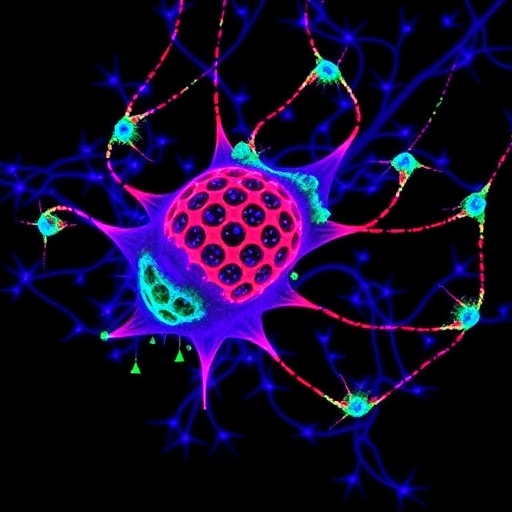In a groundbreaking advancement at the crossroads of optical spectroscopy and imaging, researchers have unveiled a novel technique that revolutionizes microscopic analysis by enabling simultaneous acquisition of Raman and fluorescence lifetime images. This cutting-edge approach, known as time-resolved photon counting Fourier-transform micro-spectroscopy (TRPC-FTMS), opens new vistas for studying complex biological systems and materials with unprecedented specificity and temporal resolution.
Traditional microspectroscopy methods often force a trade-off between obtaining spatial, spectral, or temporal information. Raman spectroscopy excels at revealing molecular vibrations and chemical compositions, while fluorescence lifetime imaging provides dynamic insights into the environment and molecular interactions. The innovative TRPC-FTMS system circumvents these limitations by integrating time-resolved photon counting with Fourier-transform spectroscopy, allowing researchers to capture both Raman spectral fingerprints and fluorescence relaxation dynamics simultaneously from the same microscopic field of view.
The crux of this technology lies in its capacity to harness interferometric data acquisition paired with ultrafast photon counting detectors. By recording the temporal arrival of photons with picosecond precision during the Fourier-transform scan, the system builds a multidimensional dataset that encodes not just spectral but also temporal decay information for each spatial location. This multiplexed detection strategy effectively disentangles overlapping signals, substantially enhancing the information content retrievable from samples that exhibit both Raman scattering and fluorescence emission.
One of the pivotal challenges addressed by TRPC-FTMS is the spectral crosstalk commonly encountered when attempting simultaneous Raman and fluorescence measurements. Fluorescence typically overwhelms the weak Raman signals, impeding accurate chemical characterization, especially in biological specimens rich in autofluorescent molecules. By capturing fluorescence lifetime parameters alongside Raman spectra, the method leverages the differing temporal signatures to separate these signals post-acquisition algorithmically, thus providing clean Raman data without fluorescence contamination.
This dual-modality imaging technique holds tremendous potential for biomedical research, where precise molecular identification coupled with insights into molecular interactions and local environment dynamics is paramount. The ability to perform simultaneous Raman and fluorescence lifetime imaging expedites investigations into cellular heterogeneity, pathological alterations, and pharmacological responses, all while minimizing photodamage and acquisition times. Consequently, TRPC-FTMS paves the way for more comprehensive, non-invasive diagnostics and live-cell imaging applications.
Fundamentally, the Fourier-transform aspect of the system confers notable advantages over traditional dispersive spectrometers. Fourier-transform spectroscopy inherently offers multiplex or Fellgett’s advantage, ensuring superior spectral resolution and sensitivity. When combined with time-correlated single-photon counting, the approach records excitation-emission dynamics with enough temporal granularity to discern subtle biomolecular interactions and microenvironmental changes that govern fluorescence lifetimes.
Technologically, the system employs a Michelson interferometer-based configuration where the sample fluorescence and Raman emissions are collected simultaneously during the interference pattern scan. The single-photon avalanche diode detectors (SPADs) capture photon arrival times with extraordinary temporal fidelity, and subsequent Fourier transformation reconstructs the spectra. Decoding the fluorescence lifetime information from the time stamps further enriches the data, producing a multidimensional portrait of the sample at microscopic resolution.
By delivering both spectral and lifetime contrasts within a single measurement, TRPC-FTMS represents a significant leap forward for label-free imaging strategies. This is particularly important in investigating living cells or fragile specimens where introducing exogenous fluorescent labels may perturb physiological functions or complicate interpretation. The approach enables intrinsic fluorescence and molecular vibrations to be exploited simultaneously, providing a more holistic understanding of biological complexity.
The implications for materials science research are equally profound. The sensitivity to chemical composition and molecular dynamics unlocked by this technology can accelerate the characterization of advanced materials, nanostructures, and composites. Studying phenomena such as energy transfer, conformational changes, or molecular diffusion with combined spectral and lifetime information enables scientists to decode material behaviors in situ and in real time, catalyzing innovations in nanotechnology and photonics.
Moreover, the efficient data acquisition and multiplexing capacity of TRPC-FTMS reduce the time burden traditionally associated with hyperspectral imaging and lifetime measurements. Faster acquisition minimizes photobleaching and phototoxic effects, which are critical constraints during prolonged observation of biological specimens. This efficiency promotes broader adoption in clinical and industrial settings, where rapid, robust analytical tools are essential.
As this imaging modality matures, integration with advanced computational methods such as machine learning and multivariate analysis is anticipated to amplify its utility. The wealth of combined spectral and temporal data poses challenges in interpretation, but also opportunities for developing automated, high-throughput analysis pipelines. These AI-driven approaches will facilitate the extraction of subtle indicators of disease states or material defects from the complex datasets generated.
In essence, the report by Shang and colleagues delineates a transformative platform that merges the virtues of Raman spectroscopy and fluorescence lifetime imaging into a cohesive, simultaneously operable system. By surmounting longstanding barriers of spectral overlap and temporal disentanglement, TRPC-FTMS offers a powerful window into the molecular underpinnings of diverse samples. The synergy of photon counting, Fourier-transform processing, and micro-spectroscopy promises to redefine standards in optical diagnostics and microscopy.
With continued enhancements, including miniaturization of components and improved detector efficiency, this technology is poised to become a staple in laboratories globally. Its applicability extends from fundamental biochemical studies to clinical diagnostics and industrial quality control, heralding a new era where comprehensive molecular imaging is accessible, fast, and minimally invasive.
In conclusion, the advent of simultaneous Raman and fluorescence lifetime micro-spectroscopy via time-resolved photon counting Fourier-transform techniques marks a milestone in optical science. This sophisticated method not only bridges the gap between distinct spectroscopic modalities but also delivers an enriched, dynamic understanding of microscopic phenomena. The collective impact of these capabilities is set to elevate research and applications across the physical and life sciences, inspiring further innovations and discoveries.
Article References:
Shang, L., Bao, X., Peng, H. et al. Time-resolved photon counting Fourier-transform micro-spectroscopy enables simultaneous Raman and fluorescence lifetime imaging. Light Sci Appl 14, 378 (2025). https://doi.org/10.1038/s41377-025-02020-8




